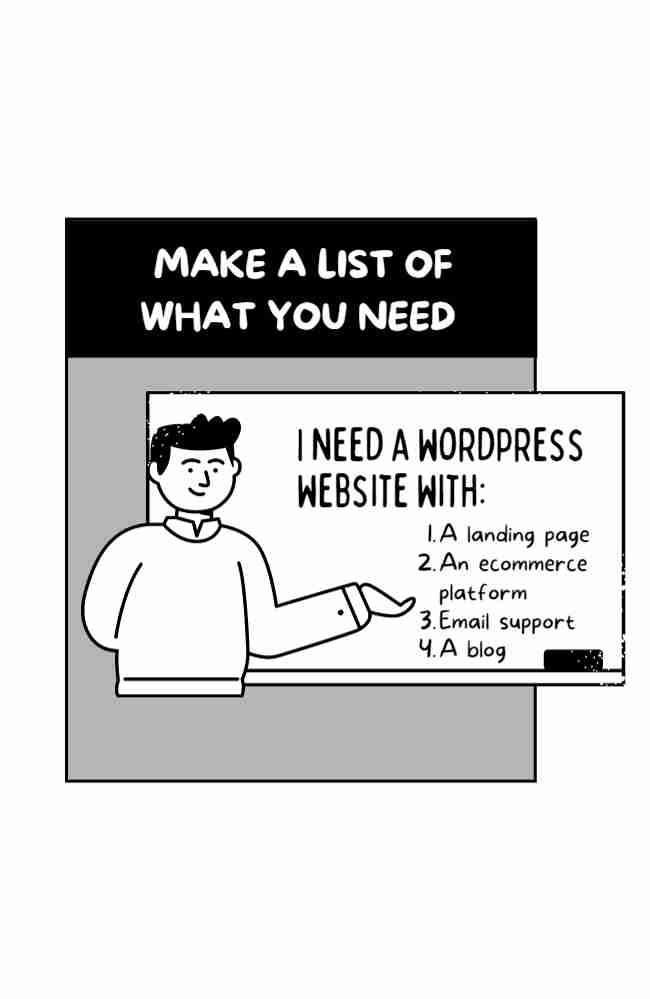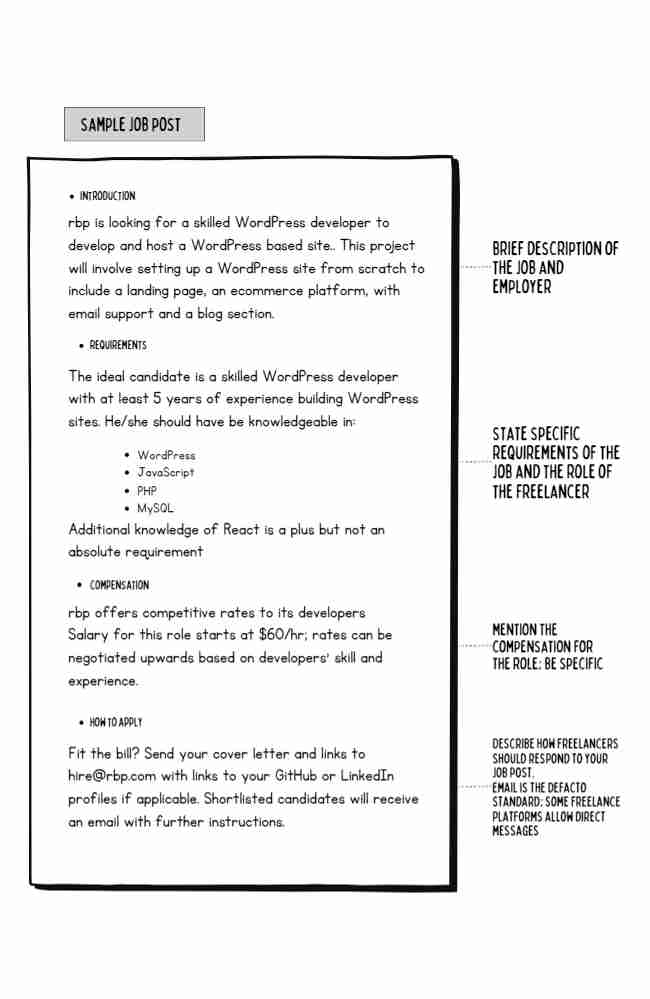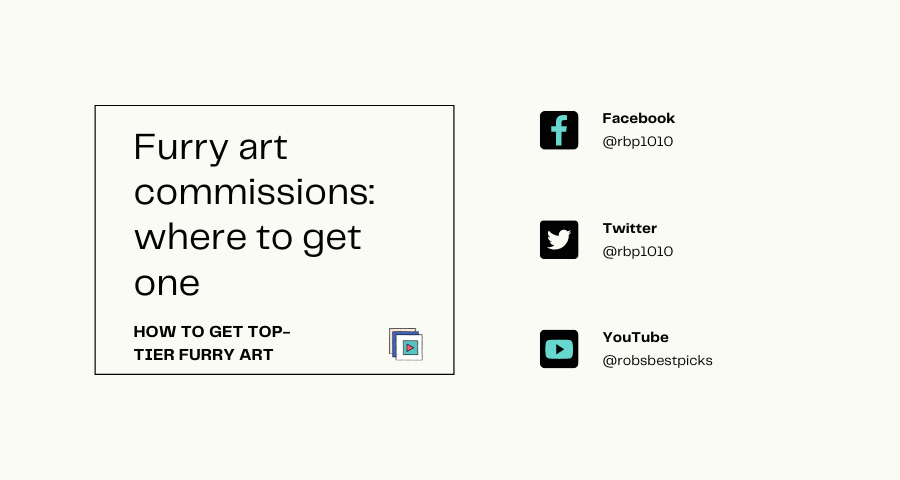We now live in what’s, for the most part, a gig economy. And while there’s a raging argument on the appropriateness of this new standard, a less debatable fact is the importance of freelancers to the success of the modern business enterprise.
Low wages, flexibility and access to what’s now a hugely diverse pool of talent attracts business owners to freelancers. If you’re the new businessman/woman in town looking to bootstrap your business, then you most certainly want to take advantage of the freelance boost. But how exactly do you hire a top-notch freelance?
First off, itemize what you want done

The key to getting the best out of freelancers is understanding what exactly you need done from the get-go. I’m not talking vague understanding – like I need to build a website – no, more like I need to build a WordPress website with four pages and with e-commerce support. Heck, now that I think about it, even this is not sufficient enough. If you want an eCommerce portal bundled into your WordPress site, you need to know the number of shoppers who’d use that portal; how many web pages will be sufficient; and the volume/type of product you’ll be promoting.
Why do you need this?
A clear idea or roadmap of what you need done allows you to select the best freelancer for your job. Freelancers come in different forms with different skills. When you understand that you need an eCommerce shop in addition to your WordPress site, you won’t go around hunting for just a WordPress developer, you’d search for a developer who’s also well versed with e-commerce sites.
A full understanding of the scope of your project also allows you to set a realistic budget. When hiring a freelancer, your budget is important, but more on this later.
A full understanding of the scope of your task means you know what you want and how you want it done. This is important so you don’t get sold unnecessary ‘extra’ services that are not worth your time or money. Freelancers are excellent upsellers, and they’ll go through hook and crook to bundle in extra services that cost a lot, take them little to no time to implement but provide little value to you.
How do you do this
Simple, take out a pen and a piece of paper or if you’re like me, launch Google docs and start typing/writing what you need done. List it out as bullet points for added brevity.
If you’re not quite familiar with the scope and extent of the task, say, you’re a traditional brick and mortar business trying to create your first website, Google is a good resource for enlightenment. A simple ‘what do I need in a blog site for my business’ typed into Google’s search bar should do the trick.
Create a detailed job description

Now, if you did a good job itemizing what you wanted done, this step would be just you transcribing what you’ve enumerated with a few extra steps. A job description is basically a formal copy of your to-do list for potential hires.
It gives both you, the freelancer and any intermediaries a clear-cut description of what’s to be expected of all involved parties.
Why do you need this?
- To firmly establish the scope of the project in the mind’s eye of potential hires.
- To screen out freelancers who don’t have the requisite skills to complete the task.
How do you do this
The ideal job description for a freelancer should always include four things amongst many others;
- The job role
- The specific duties of such a role
- The expected skills and experience
- The pay structure, which could be a flat or hourly
In writing the job description, you want to be as succinct as possible. Make sure to capture all the relevant details without being too verbose. Going back to our WordPress developer example, it makes more sense to list out all the tasks you’d expect the developer to complete as opposed to, say, telling a story about how you expect top-quality work or how important the role is to your company.
You can always garnish the job description with a description of your company and business modus operandi. But, remember, keep it short and straightforward. No one, not even freelancers, have the time to read through vainly verbose text.
Find a place to hunt for freelancers

For many, finding the right place to search for competent freelancers is about the most challenging part of the freelance hiring process. Virtually every popular online place (think Toptal, Upwork or Fiverr) has some scathing reviews to their name if you search deep enough.
But that says something – no one platform is perfect, and the only way you can dodge the imperfection on these platforms is by doing your homework right.
Why do you need this
- Freelance websites and job boards are made different, and each is excellent for searching for a particular types of freelancers. Fiverr, for instance, hands down has the best selection of lifestyle freelancers and creative artists. But if you wanted a professional writer with proven industry experience, you’d be better off starting your search on Upwork.
- You get to save time. If you know where the freelancers fitting to your needs hang out, you will save time that would’ve been spent searching elsewhere.
- Some freelance sites are outright scams, and they might reach you through ads. I’m guessing when you typed how to hire a freelancer or any other phrase that landed you on this webpage, you got served a couple of Google ads. Knowing the safe, ideal place for your search ensures you don’t fall victim to scam websites.
How do you do this
I’ll tell you from the get-go that the best and probably most secure way to hire a freelancer is through referrals. If someone you know is having a great time working with a freelancer, chances are you’d have a great time working with the same freelancer provided they can fit you into their schedule. But it’s hard to get a referral for every freelance role you’d want to fill, which is why you’d take the other routes.
Now I said that each freelance site is good for a particular reason, right? Well, if you wanted a rundown of which sites rhyme with your reason, take a look at my review of the best freelancing sites for hiring freelancers.
Make your freelancer shortlist
Let’s assume you’ve found the right freelance site. When you post your task on their job board, you’re going to get hit with multiple proposals from potential hires. Alternatively, you could type in the service you wanted on the search bar of freelance sites and get a result with freelancers that match your query. Regardless of the route you choose, you’re going to have to pick from what’s usually a large selection of freelancers. The best way to narrow down to an ideal fit for your needs is to make a shortlist.
Why you need this
A freelance shortlist is a working draft of potential hires that serves to keep your head clear on whom you should be focused on hiring.
How do you do this
Method one
If you’re posting on a job board, make sure to ask for evidence of experience and proficiency in the skills you outlined. Many applicants will come with fancy cover letters and catchy pitches, but that’s not what you’re looking for – you want a freelancer who has the experience and skills to do what you want done. While a well-crafted pitch can draw your attention to a particular proposal, your focus should be on the freelancer skill and experience. Got that?
The skill and experience requirement should weed out the majority of the applications you get, and at this point, you should create a shortlist of the freelancers who meet your requirements.
A note on experience – while very important, experience can be deemphasized for a freelancer who has irrefutable evidence of having the skills to get your task done. It shouldn’t be absolute as well – someone who has experience working with programming languages like PHP, and JavaScript for instance, most likely know his way around WordPress.
Method two
If you’re surfing through the freelance gig listing on sites like Fiverr and Upwork, you get to make the selections yourself. A click on any particular gig should take you to the freelancers’ page, from where you’d be able to see their skills and experience. If you don’t see any information on experience and skillset, simply send a message asking for evidence (samples) of previously completed projects related to your task.
NB – most freelance sites automatically rank freelancers based on their performance. So generally, when you search for any service on these platforms, you’re getting a prefetched list of who the site administrators think are best suited to the task. Much like Google ranks and presents the best results for any particular search query.
Overall, your final shortlist should be at least three but no more than ten potential freelancers.
Leverage the review system
Most freelance websites have a review system where past clients review the service they got from a freelancer. Reviews are a powerful tool to segregate excellent freelancers from average and poor sellers, but you have to be careful not to fall for fake reviews – and there’s loads of them on freelance sites like Fiverr and Upwork.
Why you need this
- Great freelancers get great reviews, so reviews are a great way to spot a freelancer who will do a great job.
- When making your shortlist, reviews can be used as a tiebreaker for picking a freelancer out of a bunch.
How do you do it
There’s a lot of fake reviews flying about, so you’ve got to be nifty when using reviews. My personal strategy is:
- Find a seller with a significant chunk of positive reviews
- Ignore the positive reviews
- Sort their reviews by ratings
- Then check out the two-star and especially three-star reviews
Here’s the logic behind this
If a freelance site is pointing you to a freelancer after you searched for a service, chances are that that freelancer is good at what they do. This is especially true for sites like Fiverr and Upwork who use algorithms to rank freelancers based on performance.
Negative reviews – the two, three stars reviews – show you the not so good parts of supposedly good freelancers. And sometimes, that’s all you need to determine if they’d be a good fit for you.
What are the negative reviews about? Is it the quality of work or the professionalism/attitude of the freelancer?
Is there a consistent theme with the negative reviews? If more than three people make the same complaint, then it is likely valid.
How did the freelancer respond to the complaint? Was it addressed? Did they take responsibility when they were wrong? Were they arrogant and dismissive?
Assessing this provides you with a behind the scenes look at who the freelancer is and how he/she runs their business.
Schedule an interview or question asking session
The interview step is the penultimate step in the freelancer hiring process. It allows you to get to know your potential hires better. It doesn’t always need to be a full-on interview – if you’re hiring for a basic task, a simple question and answer session should suffice.
Why do you need this?
So you’ve picked your shortlist using the review system, and all we’ve talked about, interviews are a way to select the best freelancer from your shortlist.
How to do it
The best interviews are those framed with objectivity in mind. Don’t ask vague questions, be direct.
Here’s my go-to template. Feel free to modify it to suit the role you’re trying to feel and brand voice.
- Introduction – Hi, name’s xxx, can I get to know you
- Explain the role – we’re looking to staff xxx position or looking to complete xxx project
- Explain what’s expected of the ideal candidate – we need someone who has xxx skills and is well versed with xxx tools.
- Ask about their experience
- Ask about relevant projects
- Ask about the tools they use routinely
- Ask for results they’ve managed to achieve
- Ask for how they manage tight schedules if they ever had tight schedules
- Ask for how they communicate with clients – frequency, communications channels and preferred time frames
- Ask for their time zones and work availability – how much time they’re able to commit to your project
- Finally, ask if they have any questions themselves
The answer to these questions should point you to the right freelancer for hire. Now let’s move to the hiring phase.
Hiring your select freelance candidate – creating a contract
Depending on the type, complexity and sensitivity of the task, you might want to drum up a freelancer contract. There are many apps to do this but read my guide on creating a freelancer contract for more information.
Platforms like Fiver and Upwork have a contract functionality built into the system. Usually, the freelancer gets to draft up the contract based on your terms for you to accept and pay.
Why you need this
- A contract is by very definition of the term, a legal document. It explicitly outlines the liabilities of all involved parties. If anything goes sideways in your dealings with the freelancer, you can always refer back to this document.
- Contracts also define the agreed-upon timeline for project/task completion
- Contracts specify the pay rate and form of payment
How to do this
- First drum up a contract complete with;
- The expected roles of the freelancer
- The expected deliverables
- The agreed pay rate
- The method of payment
- Confidentiality requirements
- Other specifications as required by the peculiar project, e.g. intellectual property rights for software, or non-disclosure agreements for ghostwritten content
- And the due date for the deliverables.
Again, sites like Fiverr and Upwork have inbuilt contract functionality on their platforms, so it’s easy to specify all of this.
A note on the method of payment
Most freelance websites have an in-house payment platform that handles the payments and escrow modalities. However, if you’re hiring a freelancer off, say, Reddit, or through a referral, you want to structure the payment in a way that provides some cover. There are two ways to ensure this:
Split payment into two
Or, if we’re talking large payments, split payments to correspond with deliverable milestones.
Use a payment platform like PayPal.
PayPal offers a buyer protection and mediation service that protects you if you don’t get the service you paid for.
The legalities around hiring a freelancer
Hiring a freelancer might be simple enough, but there are some legal considerations to take into account. Mess it up, and you could get yourself into some complicated scenarios much later.
Intellectual property (IP) rights
Freelancers are not exactly employees, so their work, be it code, graphics design, or written content, remains their intellectual property. They own the copyrights by default. It’s crucial that you transfer copyrights from a freelancer on project completion, and to do that, you’ll need to draft up an intellectual property assignment deed or copyrights agreement document. Here’s a sample.
Non-disclosure agreements
Non-disclosure agreements are adjunct ways of protecting your IP and maintaining confidentiality. They basically stop any freelancer from sharing details that surround your project – from conceptualization to execution. NDAs are simple documents to create, enforcing them offshore however, that’s not too straightforward.
Regardless, you should definitely set up a generic NDA template to use for your freelance projects. The benefits are they provide legal recourse in the case where the law is enforceable. If you don’t have them, you can’t pursue such a legal case in a place where NDAs are applicable and enforced.
The content of your work agreement
Work or service agreements are expansions of the contract document. In most cases, you serve either of the two. Your work agreement should contain everything from the payment agreement to the terms of service, contractual obligations, and the IP terms as well. When you’re dealing with offshore employees, the entire document can be a simple page or two.
Onshore workers (offering their services as freelancers) and workers from certain regions might mandate a much more detailed service agreement. Freelancers onshore might qualify as employees by law in certain conditions, for instance, and you need to cover this in your service agreement.
For more information on how service agreements work, check out this page https://itlawyersbrisbane.com.au/service-agreement/ by the guys at ITLawyers Brisbane.
Tax requirements
Freelancers are not classified as employees (well, in most cases), so you don’t have an obligation to withhold or pay payroll taxes for them. The freelancer handles their tax payments and settling themselves.
That said, if you live in the United States, you still need to complete an IRS form 1099, and for that, you need your freelancer to fill in a Form W-9.
For more information on how freelancers and taxation works, check out this blog at https://www.patriotsoftware.com/blog/accounting/working-with-freelancers/ by the guys at Patriot Software.
Rounding it up
Hiring a freelancer is a relatively straightforward process. However, you need to be as detailed as possible to make sure you get it right the first time. Not only do you save time, you also save resources you can use for other more productive pursuits.

